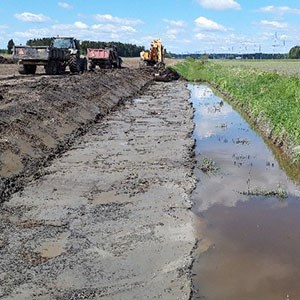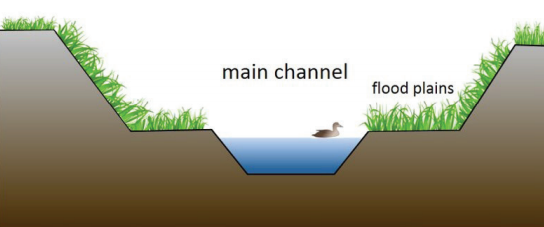Two-stage ditches

A two-stage ditch is wider than a traditional agricultural ditch. Flood plains adjacent to a base flow channel are allowed to be flooded at high flow events. This reduces the risk for erosion in the stream banks and for flooding in down stream areas.
A two-stage ditch consists of a natural base flow channel with floodplain “benches” which are adjacent to the base flow channel within a drainage ditch. Floodplains can be either one-sided or two-sided. The structure mimics the features of a natural stream and is therefore more sustainable. With two-stage ditches, natural processes reducing nutrient loads from the water are also possible. Two-stage ditches reduce erosion and flooding. It consists of a main channel, where water flows when water volume is low, and of floodplains where water has more room to flow in times of increased water volume. Vegetation in floodplains prevents erosion and removes nutrients from the water (see figure below). The construction of floodplains will also increase biodiversity in the region.
Localisation and implementation
In agricultural areas, there is a demand for environmentally sustainable solutions to improve water quality but also biodiversity. It has been estimated that one-third of the conventionally dredged agricultural brooks in Finland need maintenance since they do not provide the required drainage performance. The two-stage channels are applicable to streams that need maintenance and to improve flood control. Two-stage ditch requires more space than ordinary ditches used in agriculture, which leads to a loss of arable land.
Effects, duration and maintenance
Two stage channels provide a larger water holding capacity at high flows which can reduce downstream flooding while providing drainage. They promote fine sediment deposition on the floodplains during high flows, which will improve habitat for aquatic communities and reduce instream sediment loads. Also vegetative uptake of nutrients (e.g. by grasses) is enhanced which buffers downstream nutrient export. Two stage approach reduces bank erosion and failure, which can decrease the frequency of ditch maintenance activities especially in combination with bench sediment deposition. The surface area where denitrification can occur is larger, which increases permanent removal of nitrogen to the atmosphere, thus reducing downstream nitrogen export and eutrophication.
Two-stage ditch requires less maintenance than common ditches, but they are more expensive to construct than common ditches. The clearing of the ditch must be agreed between the actors in the area.

Two-stage ditches - extended description
Description
In order to keep fields in good cultivation status, the excess water must be removed from the fields by drainage. Balanced water economy is also needed for sufficient bearing capacity of the fields so that they can bear the machinery without excessive compression of the soil which, in turn, would be harmful for both cultivation and environment. Large-scale basic drainage of the fields in Finland was made after the World War II in order to enable better cultivation conditions. Presently, in over 70% of the drained arable area in Finland the conveyance capacity and drainage depth are no longer sufficient due to the deterioration of this aged channel network. Moreover, there is increasing need for mitigation of the harmful environmental impacts of conventional drainage (Kinnunen et al. 2020).
This “debt of maintenance” related to this invaluable part of Finnish rural infrastructure must – with one way or another – be dealt with in the next years to come. As an alternative to the conventional way of dredging the existing main ditches, the two-stage channel design is a promising new nature-based solution (NBS) for managing the excess (and shortage) of water in agriculture. Two-stage channels consist of constructed floodplain(s) on the side(s) of the existing main channel to provide extra flood capacity (Figure 1).
Localisation and implementation
Drainage channels are traditionally designed using a trapezoidal cross-section to i) serve as an outlet for subsurface tiles draining adjacent lands and ii) move that water downstream as efficiently as possible. Trapezoidal drainage channels lack floodplains and are thus prone to bank erosion and excessive buildup of sediments as the channel attempts to regain a balance between sediment transport and supply.
Two-stage channels are designed take advantage of the benefits of active floodplains. At the lower, first stage, a relatively narrow channel allows for enough velocity to minimize sediment deposition during normal or low flows. The second, horizontal higher stage provides bank stability, can act as a recipient of subsurface drainage waters, and has extra water storage capacity for the flow during larger storm events. This approach can be considered one type of in-stream best management practice (BMP) and, if properly designed, should require little or no maintenance.
Effects, duration and maintenance
Pilot studies in Midwest United States and Finland show that two-stage channels may provide water quality benefits by trapping and processing of suspended sediment (SS), phosphorus (P) and nitrogen (N) on the floodplain (e.g. Mahl et al. 2015; Västilä et al. 2016). In Finland, the effectiveness of the two-stage channel design has been evaluated thoroughly by computing the percentage of SS retention and sedimentary accumulation of P, N and carbon (C) with respect to the total transported loads over a 9-year period between summers 2010 and 2019 (Västilä & Jilbert 2021). The net retention and erosion of SS on the floodplain, main channel banks and the low-flow channel were obtained from repeated high-resolution surveys of the cross-sectional geometry. The accumulation rates of P, N and C in the deposited sediment were quantified from the vertical sedimentary mass distributions. Based on this 9-year monitoring, the sedimentary retention in the 830 m long floodplain was 6450 kg/a for SS, 4.7 kg/a for P, 23.2 kg/a for N and 228 kg/a for C. Comparing the retention to the total transported loads revealed that the retention efficiency of the floodplain was 6.8% for SS, 3.5% for P, 0.42% for N and 0.62% for C.
It is hypothesized that two-stage channels reduce sediment deposition on the channel bed, which decreases the need for maintenance and increase the channels’ life cycle. The new floodplain habitat accompanied by the more natural-like low-flow channel may also contribute to enhanced biodiversity, but scientific evidence on the impact of two-stage channels on biodiversity is so far limited (DeZiel et al. 2019). However, in a recent Finnish study (Västilä et al. 2021), two-stage channel construction appeared to be beneficial for plant biodiversity; highest number of species was recorded in the two-stage channel area, while all three conventionally dredged reference areas had lower number of plant species. The two-stage channel appeared to be beneficial to herbs favoring moist or wet conditions. This was probably due to the proximity of the wider and more uniform flooded section, i.e., in the man-made floodplain some species ‘creep’ up the bank. In terms of pollinating insects, the counts showed that various kinds of wild pollinators as well as the honeybee were relatively abundant along both kinds of studied reaches and any systematic differences between the two-stage and conventional channels with respect to pollinator species’ richness and abundance was not detected (Västilä et al. 2021).
Maintenance of a conventional, trapezoidal channel can be an ongoing problem particularly in areas that contain highly erodible soils, which are easily transported and fill in the ditch bottoms over time. Removal of excessive sediment to maintain drainage requires the use of heavy machinery, which disrupts the channel system and is costly for landowners. When coupled with appropriate upland BMPs, the two-stage design can be self-sustaining, significantly reducing the need for expensive and destructive clean-outs.
It has been estimated that the periods between the required maintenance operations of two-stage channels may be up to several decades (Paradis & Biron 2017), which increases the economically viability of two-stage channels in the longer term. The lesser need for maintenance is believed to be due to the fact that two-stage channels mimic natural conditions with natural sedimentation and flooding processes (D’Ambrosio et al. 2015). However, maintenance may still be required to remove woody vegetation, such as willows, which may obstruct water flow or shade the grasses needed to stabilize the banks.
Nevetheless, it should be kept in mind that even the oldest two-stage channels have only existed for less than 20 years and thus little is known and peer-reviewed papers about their actual life cycles are not yet available.
Two-stage ditches - links to resources
Pamphlets, reports, videos and websites
Kinnunen, O., Hjerppe, T. & Väisänen S. 2020. ELY-keskusten näkökulma luonnonmukaisten periaatteiden toteutumiseen maatalouden peruskuivatushankkeissa. Shared Waters-project report. ELY centers' perspective on the implementation of nature-based principles in agricultural dredging projects. 8 p.
Wikipedia - Two stage drainage ditch
Scientific papers
Västilä, K., Karttunen, K., Koskiaho, J., Kuussaari, M., Lehtoranta, V. & Väisänen, S. 2021. Nature-based solutions for climate change adaptation and water pollution in agricultural regions. Sustainability (submitted).
Västilä, K. & Jilbert, T. 2021. (manuscript in preparation).
DeZiel, B., Krider, L., Hansen, B., Magner, J., Wilson, B., Kramer, G. & Nieber, J. 2019. Habitat Improvements and Fish Community Response Associated with an Agricultural Two-Stage Ditch in Mower County, Minnesota. Journal of the American Water Resources Association 55(1): 154–188. DOI
Paradis, A. & Biron, P.M. 2016. Integrating hydrogeomorphological concepts in management approaches of lowland agricultural streams: Perspectives, problems and prospects based on case studies in Quebec. Canadian Water Resources Journal / Revue canadienne des ressources hydriques, 42(1): 54–69. DOI
Västilä, K., Järvelä, J. & Koivusalo, H. 2016. Flow–vegetation–sediment interaction in a cohesive compound channel. Journal of Hydraulic Engineering 142(1): DOI
D'Ambrosio, J.L., Ward, A.D. & Witter, J.D. 2015. Evaluating Geomorphic Change in Constructed Two-Stage Ditches. Journal of the American Water Resources Association 51(4): 910–922. DOI
Mahl, U.H., Tank, J.L., Roley, S.S. & Davis, R.T. 2015. Two‐Stage Ditch Floodplains Enhance N‐Removal Capacity and Reduce Turbidity and Dissolved P in Agricultural Streams. Journal of the American Water Resources Association 51(4): 923–940. DOI
Author and contact:
Pasi Valkama, Finnish Environment Institute (SYKE), Finland. e-mail

